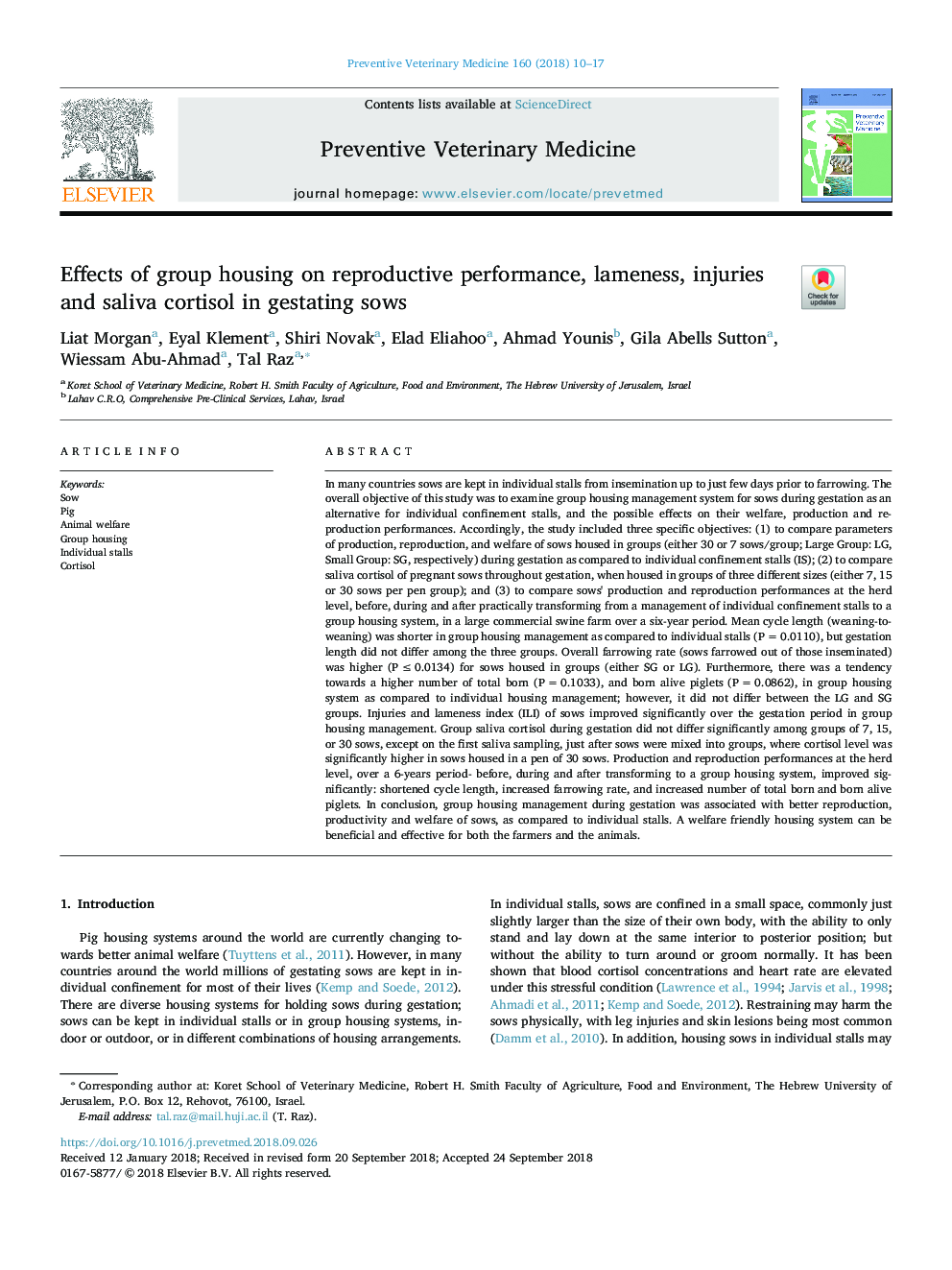| کد مقاله | کد نشریه | سال انتشار | مقاله انگلیسی | نسخه تمام متن |
|---|---|---|---|---|
| 11019401 | 1718109 | 2018 | 8 صفحه PDF | دانلود رایگان |
عنوان انگلیسی مقاله ISI
Effects of group housing on reproductive performance, lameness, injuries and saliva cortisol in gestating sows
ترجمه فارسی عنوان
اثرات مسکن گروه بر عملکرد تولید مثل، لنگش، آسیب و کورتیزول بزاق در گاوهای شیرده
دانلود مقاله + سفارش ترجمه
دانلود مقاله ISI انگلیسی
رایگان برای ایرانیان
کلمات کلیدی
کاشت خوک، رفاه حیوانات، مسکن گروهی، استقلال فردی، کورتیزول،
موضوعات مرتبط
علوم زیستی و بیوفناوری
علوم کشاورزی و بیولوژیک
علوم دامی و جانورشناسی
چکیده انگلیسی
In many countries sows are kept in individual stalls from insemination up to just few days prior to farrowing. The overall objective of this study was to examine group housing management system for sows during gestation as an alternative for individual confinement stalls, and the possible effects on their welfare, production and reproduction performances. Accordingly, the study included three specific objectives: (1) to compare parameters of production, reproduction, and welfare of sows housed in groups (either 30 or 7 sows/group; Large Group: LG, Small Group: SG, respectively) during gestation as compared to individual confinement stalls (IS); (2) to compare saliva cortisol of pregnant sows throughout gestation, when housed in groups of three different sizes (either 7, 15 or 30 sows per pen group); and (3) to compare sows' production and reproduction performances at the herd level, before, during and after practically transforming from a management of individual confinement stalls to a group housing system, in a large commercial swine farm over a six-year period. Mean cycle length (weaning-to-weaning) was shorter in group housing management as compared to individual stalls (Pâ=â0.0110), but gestation length did not differ among the three groups. Overall farrowing rate (sows farrowed out of those inseminated) was higher (Pââ¤â0.0134) for sows housed in groups (either SG or LG). Furthermore, there was a tendency towards a higher number of total born (Pâ=â0.1033), and born alive piglets (Pâ=â0.0862), in group housing system as compared to individual housing management; however, it did not differ between the LG and SG groups. Injuries and lameness index (ILI) of sows improved significantly over the gestation period in group housing management. Group saliva cortisol during gestation did not differ significantly among groups of 7, 15, or 30 sows, except on the first saliva sampling, just after sows were mixed into groups, where cortisol level was significantly higher in sows housed in a pen of 30 sows. Production and reproduction performances at the herd level, over a 6-years period- before, during and after transforming to a group housing system, improved significantly: shortened cycle length, increased farrowing rate, and increased number of total born and born alive piglets. In conclusion, group housing management during gestation was associated with better reproduction, productivity and welfare of sows, as compared to individual stalls. A welfare friendly housing system can be beneficial and effective for both the farmers and the animals.
ناشر
Database: Elsevier - ScienceDirect (ساینس دایرکت)
Journal: Preventive Veterinary Medicine - Volume 160, 15 November 2018, Pages 10-17
Journal: Preventive Veterinary Medicine - Volume 160, 15 November 2018, Pages 10-17
نویسندگان
Liat Morgan, Eyal Klement, Shiri Novak, Elad Eliahoo, Ahmad Younis, Gila Abells Sutton, Wiessam Abu-Ahmad, Tal Raz,
